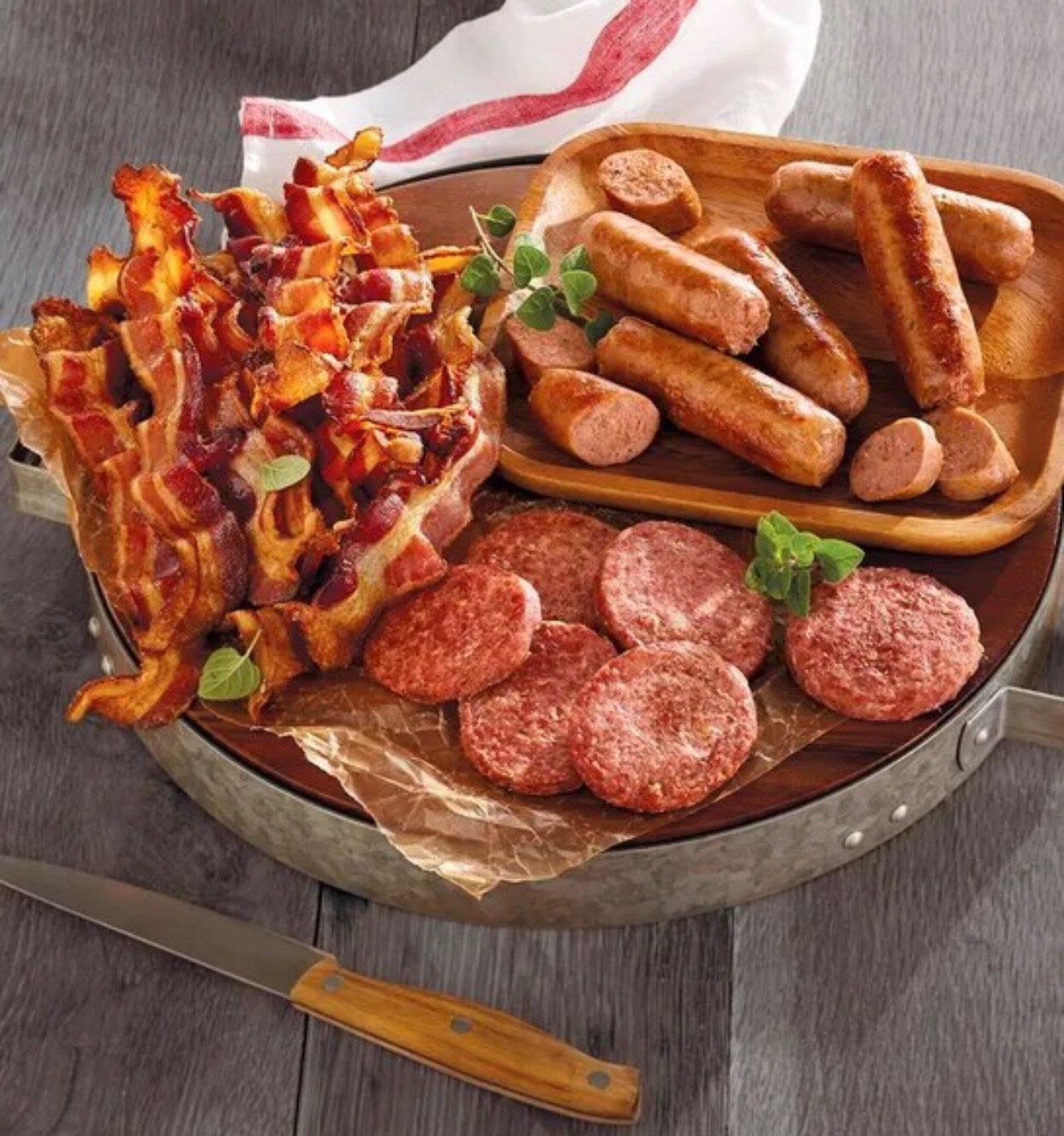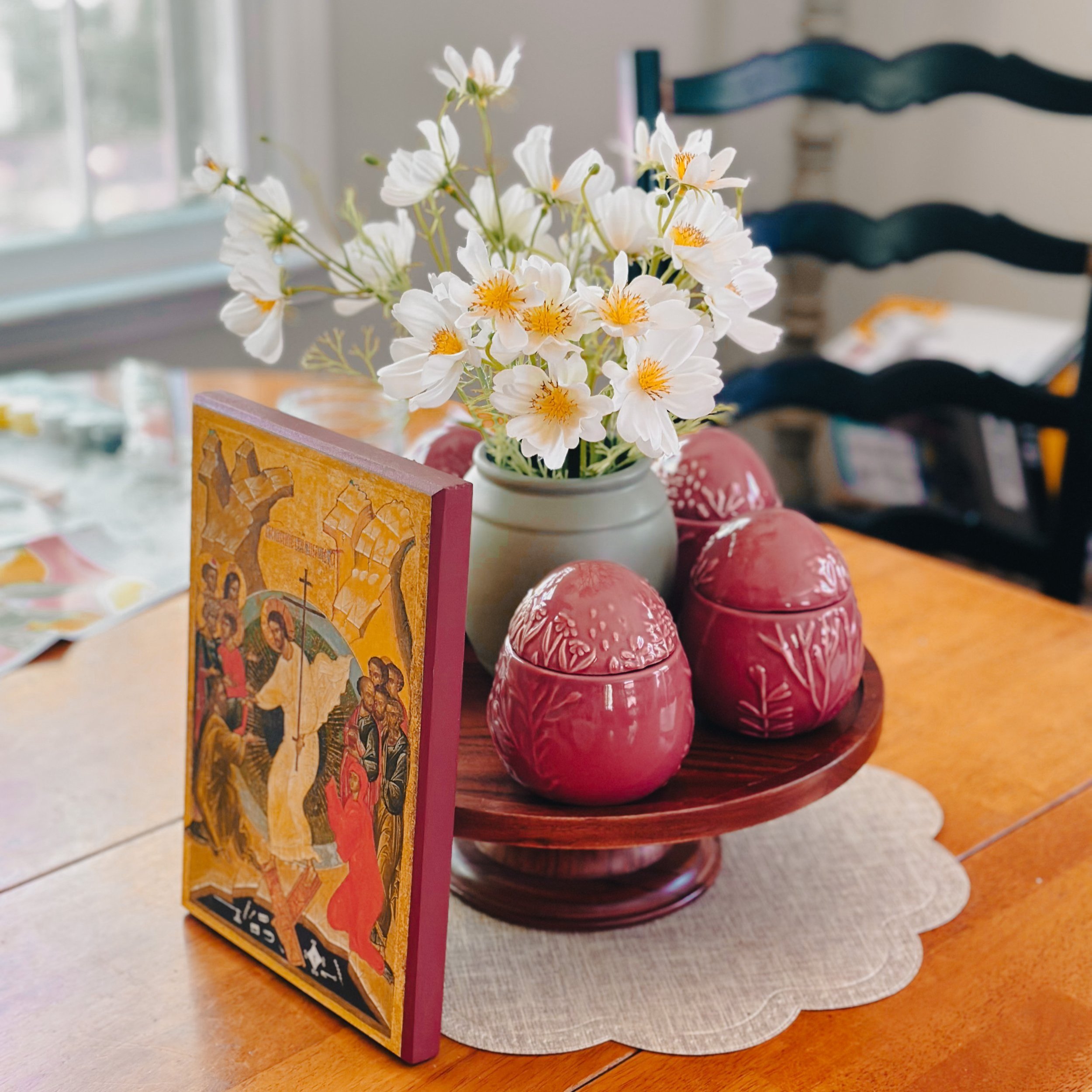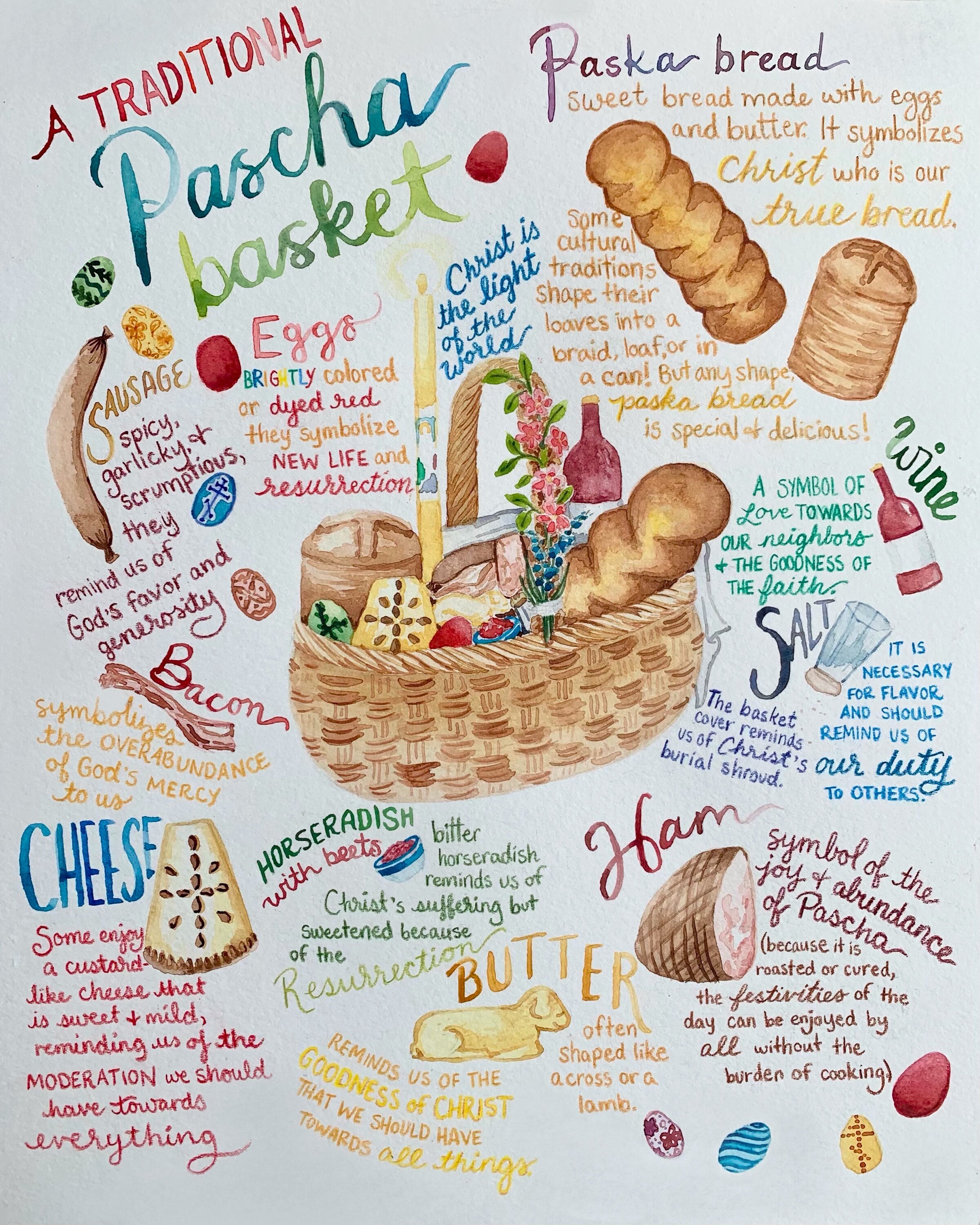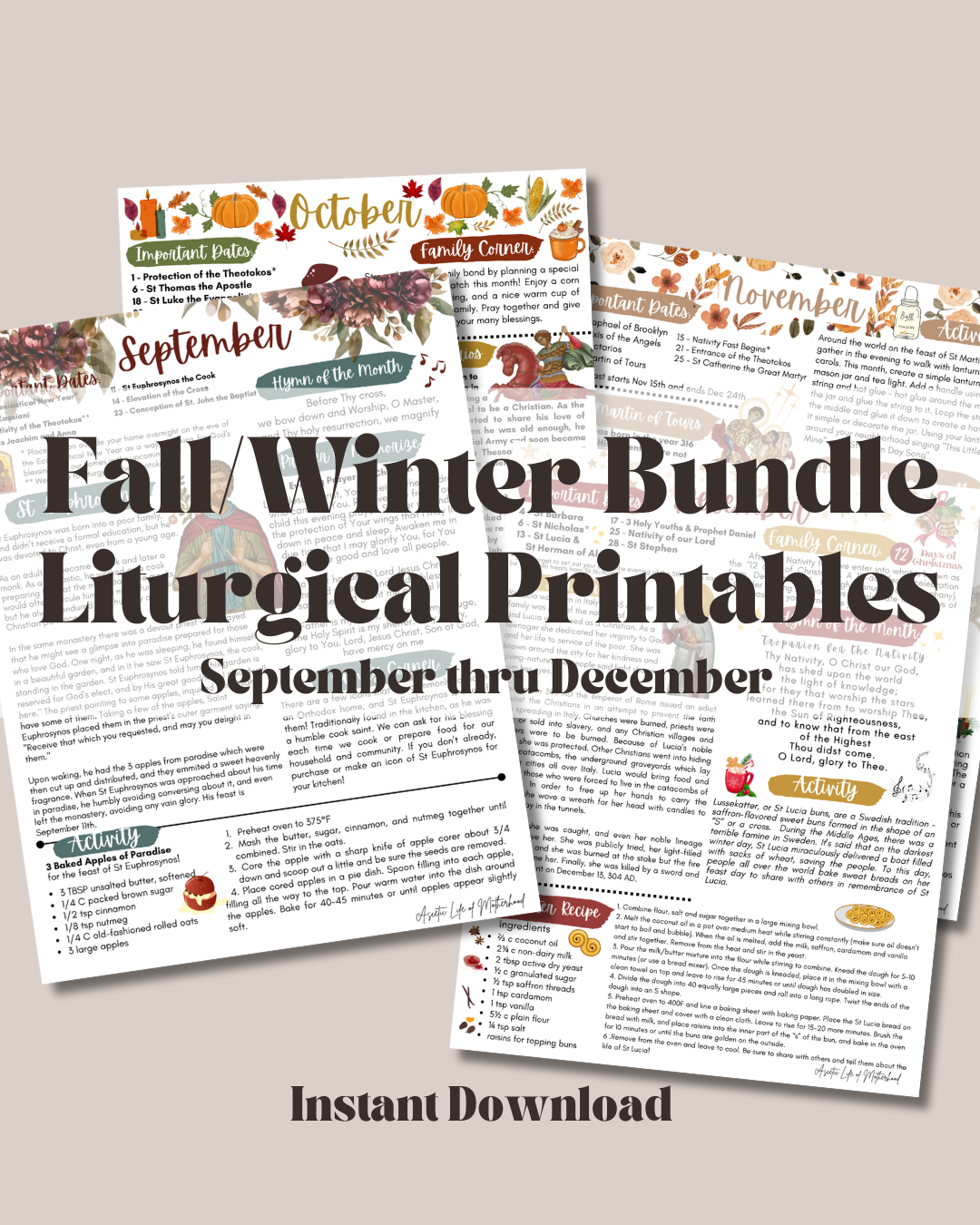How to Put Together a Traditional Pascha Basket
As Great Lent comes to a close, the faithful begin to gather a special collection of foods which have been passed down through generations; the cherished custom of the blessing of the Paschal food eaten on Easter Sunday, or better known in the east as Pascha! Each of the following traditional foods have a symbolic and spiritual significance. My hope is to share an example of a Traditional Pascha basket, which stems from the Russian tradition, and share what each item symbolizes. Although these particular items in the basket have a long standing tradition, they are in no way required! Each family will put together Pascha basket that is unique and special. It is common that family members will include items that they have been abstaining from during the fast, and items they are most looking forward to breaking the fast with after Pascha! Many parishes will bless the baskets after the Divine Liturgy so be sure to ask your local priest if this something they will do this year!
If you’re new to creating a Pascha basket, welcome! I’m glad you found this little blogpost. My hope is to simplify the traditional Pascha basket for you, so you understand the reasons behind each item that is included, AND I want you to feel the freedom to create your own perfectly customized basket that is perfectly suited for your family. Each family will put together Pascha basket that is unique and special. This is a “little t” tradition, as we often refer to it, meaning it is something that is done as a local tradition, and not universally practiced.
Scroll to read about each of these items and their symbolism
Can I include other items in my basket?
Absolutely! Think of it this way… after 40+ days of fasting, what foods do you want to eat on Pascha to break the fast? It is common that family members will include items that they have been abstaining from during the fast, and items they are most looking forward to breaking the fast with after Pascha! Although I’ve laid out the traditional foods, you can certainly make this your own! In our family basket, we’ve done a mixture of both the traditional items + other items we have been missing like one year we had Chick-Fil-A chicken nuggets, or a specialty beer, Krispy Kreme Donuts, and we even included a massive cheeseburger one time from our favorite local burger place! The possibilities are endless!
Each of us have the unique opportunity to create our own traditions, whether they are practiced in our communities or in our homes. The Pascha basket itself is one of those traditions we started before our kids were born and now it is a cherished tradition. As we draw closer to Pascha, I begin to quiz everyone in the family about what they are hoping we have for our Paschal meal. So consider asking each member of your family what items they would like to include in your family basket. One of the most profound things about our tradition is the Church takes ordinary food, blesses it, and it is used as an aid in making us holy. So enjoy curating the perfect Pascha basket for you and your household!
Putting Together a Traditional Pascha Basket
The Basket
Typically there is one large wicker basket with a handle per family. Some families may choose to have a separate basket for the children with gifts, candy, etc. If you do not have a large basket 🧺 try finding one at your local thrift stores, second hand websites (like Facebook Marketplace, Craigslist, etc), HomeGoods, or other home decor stores.
Store Bought Option: If you have a Whole Foods nearby, they sell well made fair trade Bolga Market baskets that would work great for a Pascha Basket! Or check out my Amazon list on my storefront!
Paska Bread (Easter Bread)
Paska Bread - is a rich sweet bread made with milk, butter, eggs, and made with yeast. The bread reminds us that Jesus is the bread of life (John 6:35). The yeast is a symbol of the New Covenant; the Jews made unleavened bread, and since we are children under the New Covenant, we make leavened bread.
Store Bought Option: Each culture has its own eggy sweet bread. You can find some more traditional versions below. But if you’re needing a simple store bought option, look for some Brioche bread or Hawaiian rolls or even some crescent rolls as a great store bought option to add to your Pascha Basket!
Traditional Sweet Breads:
Paska
Paska is the Ukrainian or Georgian traditional bread, decorated with a braided cross on top and baked in a round cake pan. You can find step by step instructions on how to make this bread HERE thanks to Korena in the Kitchen Blog.
Kulich
Kulich is the traditional Russian bread, often made with dried fruit and decorated with icing and sprinkles. The process of this bread is quite lengthly (totaling 7+ hours) but much of that is passively for the various rises. You can follow a step by step recipe HERE thanks to Natasha’s Kitchen Blog. You can shop various paper molds for kulich in my Amazon storefront. Perfect Pascha gifts to give to friends!
Tsoureki
Tsoureki - is the traditional Greek braided bread. The braided form of this bread is a display of the Trinity - 3 in 1. This semi-sweet bread is made using eggs, butter and cream. You can follow a step by step recipe HERE thank to Hey Foodie Girl, an Orthodox Food Blogger, which will make a bunch of loaves to share!
Eggs
Eggs - Brightly Colored or dyed red, they symbolize new life and the resurrection. The red egg, which we crack, reminds us of the tomb from which Christ arose. This is because of the miracle of new life which comes from the egg, just as Christ miraculously came forth from the tomb, shattering the bonds of sin. Of course, red for His blood shed for us, and the miracle from St Maria Magdalane when the egg in her hand miraculously turned red as she proclaimed "Christ is Risen" to the non-believing Emperor.
Pysanky
Pysanky is a Ukrainian Easter egg, decorated with traditional Ukrainian folk designs using a wax-resist method. The word pysanky comes from the verb pysaty, "to write" or "to inscribe", as the designs are not painted on, but written (inscribed) with beeswax. You can watch a video on YouTube on how to make these special painted eggs HERE.
Pysanky Egg Decorating Kit by Draw Near Designs
Wooden "Pysanky" Eggs for Little Ones by Draw Near Designs
A Kid's Guide to Decorating Ukranian Easter Eggs book - This book is a thorough, fully illustrated step-by-step guide for beginners of all ages! It’s designed to teach the basic skills needed for decorating pysanky. 48 full color pages, spiral bound. A perfect accompaniment to the Pysanky Egg Kit!
Rechenka's Eggs by Patricia Polacco - A story of an old Babushka, known throughout all of Moskva for her beautifully painted Pysanky eggs, is preparing her eggs for the Easter Festival when she takes in an injured goose who breaks all her eggs, but miraculously receives beautifully adorned eggs in return for nurturing the injured goose. This sweet story is available at most local libraries. You can also find it on Amazon.
Store Bought Option: If you are able to find an easter egg dying kit, you can use a crayon to decorate the eggs and dip them in various colors! Or you can find a few already beautifully decorated pysanky eggs in my Amazon storefront!
Red Dyed Eggs
Dye Red Eggs - In the Greek tradition, Holy Thursday is the day designated to dye red eggs. The red color is symbolic of Christ’s blood, and since Holy Thursday evening’s service (which is done in anticipation of Friday) is the day when Jesus is nailed to the cross, the many choose to dye their eggs on this day. Many churches provide red eggs for the faithful, which are then distributed after the Paschal Liturgy, but if you’d like to try your hand at making them yourself, there are a few ways to do this:
Natural Red Onion Dye Kit - I tried this kit this year and I was sooo impressed with how simple and easy it was. 10/10 would recommend. In fact, watch my tutorial on instagram HERE where I filmed making the red eggs using this kit. You can find this kit exclusively at Legacy Icons! Enjoy 15% off your order with coupon code ALM15 at checkout! You can find it HERE.
Onion Skin DIY Method - If you’re wanting a natural way to dye eggs, try the onion skin method! You’ll need the papery skin of about 10-12 brown/yellow onions to make this happen. Some people collect onion skins throughout lent, but if you’ve forgotten, go to your local grocery store and ask if you can take some of the papery onion skins left around the onions in the produce aisle. They may look at you funny, but I’m sure they won’t mind you cleaning up for them a bit! You can find the recipe to make them HERE thanks to Charlotte Riggle’s blog, or you can also find a “how-to” video on YouTube HERE.
Red Dye - You can also buy high-quality dye to easily prepare vibrant traditional red eggs HERE from Legacy Icons.
Paska Cheese
Cheese - Some enjoy a custard-like cheese that is sweet and mild, reminding us of the moderation we should have towards everything.
Store Bought Option: If you’re looking for a store bought option, pick cheeses you know your family will love! Feta, Bulgarian Cheese, Mozzarella, or any other artisan cheeses you love!
Paska Cheese Recipes
Paska Cheese this recipe for a Easter cheese dessert is made using Farmer’s cheese, eggs, unsalted butter, sugar and dried fruit and is made in a special mold. The process is lengthy, often taking several days. Russian, Ukrainian, and Polish cuisine all feature paska in their Pascha basket and is paired with kulich or paska bread which is blessed by the parish priest. You can follow a step-by-step recipe HERE thanks to The Spruce Eats. You will need a mold + cheesecloth. Here are a few links:
Small Flower Pot with a hole on the bottom - can find at Home Depot or Lowes
Cheese Cloth - sold by Amazon
Quick and Easy Pascha Cheese by Matushka Emily
Don’t have a mold or 2 days to prepare? I got you….
Two Easy and Quick Cheese Pascha Recipes:
Cream Cheese Cheese Pascha & Cream Cheese Cheese Pascha by Charming the Birds from the Trees Blog. Both of these recipes are cream cheese based, and are simply prepared by mixing the ingredients, setting them in a bowl, and decorating with a simple cross on top. Great for a last minute addition to your basket, and won’t take days of preparation. You can find the recipes HERE:
Cream Cheese Cheese Pascha
Ingredients
1lb softened cream cheese
2/3 cup sour cream
1 1/2 sticks butter
2/3 cup powdered sugar
1 teaspoon vanilla
golden raisins and/or silvered almonds for decorating
Method
Cream butter and cream cheese. Add powdered sugar and vanilla and continue to mix. Add sour cream. Spoon into a nice serving bowl, smooth, and decorate the top with golden raisins and/or silvered almonds. Chill, covered, for several hours before serving. Enjoy spread on kulich or Greek Pascha bread (or by the spoonful!).
Grandmama's Fruity Cheese Pascha
Ingredients
12oz cream cheese
1/4 lb sweet whipped butter
1/2 cup sour cream
4 tablespoons Sugar
1/2 cup chopped nuts
1/2 cup crushed, drained pineapple
1/4 cup yellow raisins
1/4 cup chopped, drained maraschino cherries
Method
Combine ingredients. Spoon into a nice serving bowl and smooth the top. Decorate with yellow raisins. Cover and chill before serving atop kulich or Greek Pascha bread. Enjoy!
Meat : Sausage, Bacon, Ham
Here are the typical meat items that are included in a traditional Pascha Basket. The meat products symbolize the sacrificial animals of the Old Testament, foreshadowing the true sacrifice of our Savior, who became for us “the Lamb of God, taking away the sins of the world.” As we learn from the prayer of blessing, the meat products also symbolize the fattened calf prepared for the Prodigal Son on his return to his Heavenly Father. These items can be purchased already prepared at most grocery stores:
Sausage - spicy, garlicky and scrumptious, they remind us of God’s favor and generosity
Bacon - symbolizes the overabundance of God’s mercy
Ham - is a symbol of the joy and abundance of Pascha!
Butter
Butter- often shaped like a cross or a lamb, the butter reminds us of the goodness of Christ.
Store Bought Option: Bring a stick of butter of store bought butter! Doesn’t have to be in a fancy shape. But if you’d like to try your hand at a fun mold, simple bring butter to room temperature, and fit into mold, chill and remove. Check out these links below:
Lamb Butter Mold - You can use a candy mold and use it for butter, available on Amazon
Check out other items for your Pascha basket in my Amazon storefront!
Salt
Salt - reminds us that we are the salt of the earth referenced in Matthew 5:13-16 : “You are the salt of the earth; but if the salt loses its flavor, how shall it be seasoned? It is then good for nothing but to be thrown out and trampled underfoot by men.” Salt is also necessary for flavor, and reminds the Christian of his duty to others. As salt preserves food, we are to be as salt in the world.
Store Bought Option: Any salt will do! Since traditionally Pascha baskets are blessed, you can take it home and use it for all your cookings or flavoring during the Paschal season! My favorite salt is HERE.
Bitter Herb
Horseradish with Beets - In some traditions mixed with grated red beets, this is symbolic of the Passion of Christ still in our minds, but sweetened with sugar because of the Resurrection. A bitter-sweet red mixture reminds us of the sufferings of Christ. Having a bitter herb also reminds us of the vinegar that was offered to Christ while he was on the cross.
Store Bought Version - You can easily buy prepared horseradish to include in your basket. But also, if you’re not a fan of horseradish, include any bitter herb of your choosing like prepared mustard.
Ćwikła Recipe
In the Polish tradition, there is a grated horseradish dish with Beets called Ćwikła (CHEEK-wah). This no-cook recipe combines grated horseradish with beets. It is the perfect accompaniment for the sausage and ham. The ratio of horseradish to beets is generally 1 to 3, giving this dish a more mild taste compared to other horseradish condiments. This recipe provides canned and jarred alternatives, but it will taste best with fresh ingredients. You can find the recipe HERE thanks to The Spruce Eats.
Wine
Wine - Reminds us that God takes ordinary food and uses it as an aid in making us holy. From Matthew 26:27-29 “Then He took the cup, and gave thanks, and gave it to them, saying, “Drink from it, all of you. For this is My blood of the new covenant, which is shed for many for the remission of sins. But I say to you, I will not drink of this fruit of the vine from now on until that day when I drink it new with you in My Father’s kingdom.”
Candle
Candle - traditionally a Pascha basket includes a decorated candle. During the eating of the Paschal food, this candle is placed in the middle of the table. Jesus is the true light who brightens the whole world through the radiance of His Holy Resurrection. You can find some candles below:
Decorate Your Own Pascha Candle Kit by Draw Near Designs HERE
For Kids: Electric Flickering Pascha Candle by St Marina Place HERE
Kids Battery Operated Candle Decorating Kit by Orthodox Icon Friends on Etsy
Australia - Lambathes (Pascha Candles) by Evlogia Gifts HERE
Pascha Cover
Pascha Cover (Cloth) - the cover reminds us of Christ’s burial shroud. A traditional basket cover is made with a white cloth embroidered with the words, “Christ is Risen,” but there are many beautiful designs available through Orthodox makers, which you can see below:
Paschal Floral Towel (above) Designed by Abigail Art and sold through Draw Near Designs. They actually have a BUNCH of designs, so be sure to check out there LENT + PASCHA shop!
Pascha Embroidery Kit by Avlea Folk Embroidery
Linen Pascha Covers from Etsy (you can find a ton of beautiful designs on Etsy)
Source: HERE
Final Thoughts
Each family will put together Pascha basket that is unique and special. The purpose of this guide is to share the contents of a traditional Pascha basket. Don’t take it as a rule that has to be followed. This is a “little t” tradition, as we often refer to it, meaning it is something that is done as a local tradition. Even with a traditional basket, each basket will take on its own life. Whatever you do, I pray it is a blessing for you and your household!
Thank you for all your support and for checking out my latest Feast Day guide. Good strength, dear friends! We are nearly there to the joyous day of Resurrection!
-Khouria Destinie
































